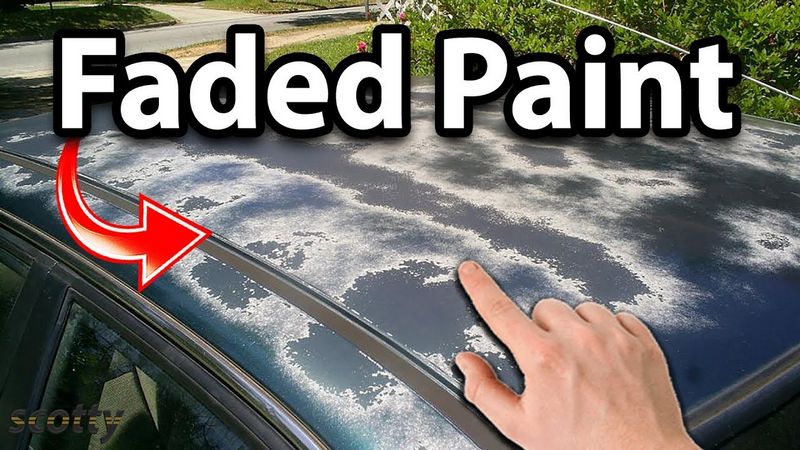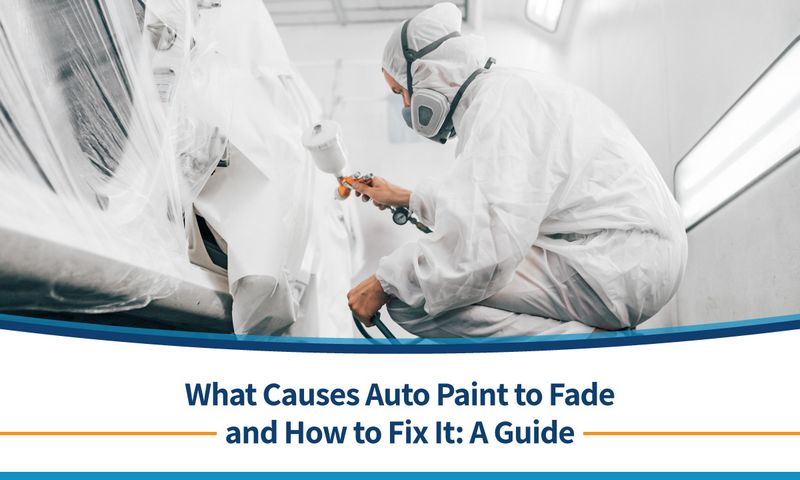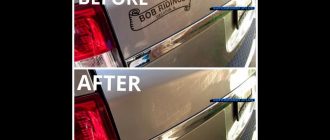
What Causes Auto Paint to Fade and How to Fix It: A Guide
Auto paint fading is a common issue that many car owners encounter. Over time, the vibrant color of your vehicle can gradually diminish, leaving it looking dull and lackluster. So, what causes auto paint to fade? There are several factors that contribute to this problem, including exposure to sunlight, harsh weather conditions, and improper care and maintenance.
One of the main causes of auto paint fading is ultraviolet (UV) radiation from the sun. The UV rays break down the chemical bonds in the paint, causing it to lose its color and shine. Other environmental elements, such as rain, snow, and pollution, can also accelerate the fading process. Additionally, using improper car cleaning products or techniques, such as abrasive cleaners or incorrect waxing, can further damage the paint and make it more prone to fading.
But don’t worry, there are ways to fix and restore the faded auto paint. First, you can try using a high-quality car polish to gently remove the faded layer and reveal the original color. Make sure to choose a polish that is specifically designed for restoring paint and follow the manufacturer’s instructions for best results. If the fading is more severe, you may need to consider repainting the affected areas or even the entire car. It’s recommended to consult a professional auto painter to ensure a proper and long-lasting restoration.
In conclusion, understanding the causes of auto paint fading is the first step towards finding a solution. By taking the necessary precautions and following the right maintenance practices, you can prevent and minimize paint fade. And if the fading does occur, there are various techniques and services available to help you restore your car’s paint and bring back its original brilliance.
Common Causes of Auto Paint Fading
Auto paint fading is a common issue faced by car owners, and understanding its causes can help you prevent and fix it. Here are some common causes of auto paint fading:
- Exposure to the sun: Ultraviolet (UV) rays from the sun can cause the paint to fade over time. Prolonged exposure to sunlight can break down the paint’s pigments and protective coating, causing it to lose its shine and color.
- Environmental pollutants: Air pollutants, such as smog, acid rain, and industrial fallout, can also contribute to paint fading. These pollutants can react with the paint’s surface and cause it to deteriorate, leading to fading.
- Chemical damage: Certain chemicals, such as gasoline, solvents, and cleaning agents, can be harsh on auto paint. If not rinsed off properly, these chemicals can strip away the paint’s protective layer and cause fading.
- Improper car care: Neglecting proper car care can accelerate paint fading. Lack of regular washing, waxing, and detailing can leave the paint vulnerable to damage and fading.
- Physical damage: Scratches, chips, and dents on the car’s surface can expose the underlying layers of paint to the elements, leading to fading. Additionally, abrasive cleaning techniques can also cause paint damage and fading.
To prevent auto paint fading, you can take the following steps:
- Protect your car from the sun: Park your car in a shaded area or use a car cover to shield it from direct sunlight.
- Keep your car clean: Regularly wash your car to remove dirt, grime, and pollutants that can contribute to fading.
- Wax your car: Applying a protective layer of wax can help shield the paint from UV rays and environmental damage.
- Use a paint sealant: A paint sealant can provide an additional layer of protection against fading.
- Address scratches and chips: Fix any scratches or chips in the paint as soon as possible to prevent further damage and fading.
- Avoid harsh chemicals: Use gentle cleaning agents and avoid using abrasive materials or techniques that can damage the paint.
By understanding the causes of auto paint fading and implementing proper care and protection, you can keep your car’s paint looking vibrant and fresh for longer.
Exposure to Sunlight
Exposure to sunlight is one of the main causes of auto paint fading. The harmful ultraviolet (UV) rays from the sun can gradually break down the chemical bonds in the paint, causing it to become dull and faded over time. This process is known as photooxidation. Additionally, prolonged exposure to sunlight can also cause the clearcoat, which protects the paint, to degrade and peel off.
To fix and prevent auto paint fading caused by sunlight, here are some steps you can take:
-
Regularly wash and wax your car: Washing your car regularly can remove dirt and other contaminants that can accelerate paint fading. Applying a layer of wax can provide an additional protective barrier against UV rays.
-
Park in shaded areas: Whenever possible, park your car in shaded areas or use a car cover to protect it from direct sunlight.
-
Use UV protection products: There are various UV protection products available in the market, such as UV-blocking films and sprays. These products can be applied to the paint surface to block the harmful UV rays and slow down paint fading.
-
Seek professional help: If your car’s paint has already faded significantly, it may require professional restoration. Professional auto paint restoration techniques, such as compounding, polishing, and clearcoat application, can help restore the color and shine of your car’s paint.
By following these steps and taking proper care of your car’s paint, you can minimize the effects of sunlight exposure and keep your auto paint looking vibrant and fresh for longer.
Oxidation
Oxidation is one of the main causes of paint fading on auto surfaces. It occurs when the paint is exposed to oxygen for an extended period of time.
Over time, the oxygen in the air reacts with the chemicals in the paint, causing it to break down and fade. This process is known as oxidation.
When oxidation occurs, the fresh and vibrant color of the paint begins to fade, and the surface can become dull and lackluster. In some cases, the paint may even start to peel or crack.
In order to fix paint fading caused by oxidation, it is important to properly restore the paint surface. Here are some steps on how to fix paint fading caused by oxidation:
- Start by thoroughly cleaning the auto surface using a gentle car soap and water. This will remove any dirt, debris, or contaminants that may be on the surface.
- Next, use a paint cleaner or clay bar to remove any remaining oxidation or surface imperfections. This will help to smooth out the paint surface and prepare it for the next steps.
- After the surface is clean and smooth, apply a high-quality paint sealant or wax to protect the paint from further oxidation and fading.
- Regularly maintain and care for the paint by washing it with a pH-neutral car shampoo and applying a protective coat of wax every few months.
By following these steps, you can effectively restore auto paint that has faded due to oxidation and prevent further fading in the future.
Harsh Chemicals
One of the causes of auto paint fading is the use of harsh chemicals. When harsh chemicals come into contact with the paint on your car, they can cause it to fade over time. This can happen when you use certain cleaning agents, solvents, or even certain types of car washes that contain abrasive chemicals.
These chemicals have the ability to break down the protective layer of the paint, causing it to become dull and lose its shine. They can also strip away the color pigments, leading to a faded appearance.
To prevent fading caused by harsh chemicals, it is important to avoid using them on your car’s paint. Instead, opt for gentle cleaning agents that are specifically designed for automotive use. Look for products that are pH balanced and free from harsh solvents or abrasives.
When washing your car, use a soft sponge or microfiber cloth to gently clean the paint surface. Avoid scrubbing too hard, as this can cause damage to the paint. Rinse the car thoroughly to ensure that all residue from cleaning products is removed.
If you have already experienced fading due to harsh chemicals, there are ways to fix it. You can try using a paint restoration kit or seeking professional help from an auto body shop. These methods can help to restore the color and shine of your car’s paint.
Remember, prevention is always better than cure. By understanding the causes of auto paint fading and taking the necessary precautions, you can keep your car looking its best for years to come.
Improper Washing
Improper washing techniques are one of the main causes of auto paint fading. When you wash your car incorrectly, you can unintentionally remove the protective layers of paint and expose it to harsh elements that cause fading.
Here’s a guide on how to properly wash your car to prevent paint fading and maintain its shine:
- Use the right tools: Use a soft sponge or microfiber cloth to wash your car. Avoid using abrasive materials such as brushes or scrubbers, as they can scratch the paint and cause damage.
- Choose a gentle soap: Use a car shampoo or soap specifically designed for automotive use. Avoid using household cleaners or detergents, as they can be too harsh and strip away the protective coatings on the paint.
- Wash in the shade: Wash your car in a shaded area to prevent the soap from drying too quickly and leaving streaks. Direct sunlight can also cause the soap to evaporate quickly, making it difficult to rinse off completely.
- Start from the top: Begin washing your car from the top and work your way down. This prevents dirt and debris from being dragged across the surface, reducing the risk of scratching the paint.
- Rinse thoroughly: After washing, rinse your car thoroughly with water to remove all soap residue. Any leftover soap can contribute to paint fading if left on the surface for an extended period.
- Dry with a soft cloth: Use a clean and soft microfiber cloth to dry your car after washing. Avoid air-drying or using abrasive materials, as they can leave water spots and damage the paint.
By following these simple steps, you can help prevent auto paint fading caused by improper washing. Regular maintenance and proper care are essential to keep your car’s paint looking vibrant and glossy for years to come.
Environmental Factors
Auto paint fading can be caused by a variety of environmental factors. The sun, rain, wind, and pollution all play a role in the degradation of your vehicle’s paint job. Understanding these environmental causes can help you take steps to prevent and fix paint fading.
Sun Exposure: One of the primary culprits behind paint fade is the sun. Ultraviolet (UV) rays can penetrate the clear coat and damage the pigments in the paint, causing it to fade over time. Additionally, excessive heat from the sun can accelerate the fading process.
Rain and Moisture: Rainwater and moisture can also contribute to paint fading. When water sits on the surface of your vehicle for long periods of time, it can seep into the paint and cause it to peel or bubble. This can lead to a dull and faded appearance.
Wind and Debris: Strong winds and flying debris can scratch and chip the paint, leaving it vulnerable to fading. Sand, dust, and other particles can act as abrasive agents, gradually wearing away at the paint’s protective layers and causing it to fade over time. Bird droppings can also be highly damaging to paint if not promptly removed.
Air Pollution: Pollutants in the air, such as smog and industrial emissions, can also contribute to paint fade. These pollutants can react with the pigments in the paint, causing discoloration and degradation. The acidic nature of some pollutants can further accelerate the fading process.
To fix auto paint fading caused by environmental factors, there are several steps you can take. Regularly washing and waxing your vehicle can help protect the paint from UV rays, moisture, and debris. Using a car cover can offer additional protection, especially if your vehicle is parked outdoors for extended periods of time. Lastly, consider using UV-protective products and coatings to help shield your vehicle’s paint from the sun’s harmful rays.
Signs of Auto Paint Fading
If you notice that the paint on your car has started to fade, it is important to take action to fix it as soon as possible. Paint fading can not only make your car look old and worn out, but it can also leave the underlying metal exposed to the elements, leading to further damage like rust. In this guide, we will discuss the signs of auto paint fading and how to restore it effectively.
Faded Color: One of the most common signs of paint fading is a noticeable change in the color of your car. The vibrant and glossy look that your car once had may start to appear dull and lackluster. The color may fade unevenly, with certain areas being more affected than others.
Loss of Gloss: Another sign of paint fading is the loss of gloss. The surface of your car may no longer reflect light in the same way it used to. Instead of a shiny appearance, the paint may look flat and matte.
Chalky Appearance: Faded paint may develop a chalky or powdery appearance. This is caused by the degradation of the paint’s protective clear coat, which is responsible for providing shine and durability to the finish. The chalking effect can be felt when you run your hand over the surface.
Patchy Discoloration: In some cases, the fading of the paint may result in patchy discoloration. Certain areas of the car may appear more faded than others, creating an uneven or blotchy look. This can be particularly noticeable on horizontal surfaces such as the hood, roof, and trunk.
Visible Oxidation: As the paint fades, the underlying metal may become exposed to the elements. This can lead to oxidation, which appears as small rust spots or discoloration on the surface of the car. If left untreated, oxidation can cause the paint to peel or chip away.
To fix and restore faded auto paint, it is essential to first identify the causes of the fading. Common causes include exposure to UV rays, environmental pollutants, improper car maintenance, and harsh weather conditions. Once the causes have been addressed, various restoration methods can be used, such as polishing, compounding, and sealing, to bring back the color and gloss of the paint.
In conclusion, recognizing the signs of auto paint fading early on can help you take the necessary steps to fix and restore it. Regularly inspecting your car’s paint and providing proper maintenance can prevent further damage and keep your vehicle looking its best for years to come.
Faded Color
The fading of auto paint can be a frustrating issue for car owners. Over time, factors such as sunlight, environmental pollutants, and even improper car washing techniques can cause the paint on a vehicle to fade. Understanding the causes of paint fading and how to fix it can help car owners maintain the appearance of their vehicles for longer.
Causes of Auto Paint Fade
- Sunlight: The UV rays from the sun are one of the main causes of paint fading. Prolonged exposure to sunlight can break down the pigments in the paint, leading to a loss of color intensity.
- Environmental Pollutants: Pollutants in the air, such as acid rain and industrial fallout, can also contribute to paint fading. These pollutants can react with the paint and cause it to degrade over time.
- Improper Car Washing: Using harsh cleaning products or abrasive materials when washing a car can damage the paint and accelerate fading. It’s important to use gentle cleaning methods and products specifically designed for automotive use.
How to Fix Auto Paint Fade
If your car’s paint has already started to fade, there are several steps you can take to restore its color:
- Wash and Dry: Start by giving your car a thorough wash using a gentle automotive soap. Be sure to dry it properly to prevent water spots.
- Polish: Once the car is dry, you can apply a car polish to remove any surface imperfections and restore shine. Choose a polish that is specifically designed for faded paint.
- Touch up: If there are any small areas of paint fade or damage, you can use touch-up paint to repair them. Follow the instructions provided with the touch-up paint for best results.
- Protect: To prevent further paint fading, it’s important to protect your car’s paint from the damaging effects of the sun and environmental pollutants. You can do this by regularly waxing your car and parking it in shaded areas when possible.

By understanding the causes of auto paint fade and following these steps to fix it, you can keep your vehicle looking its best for years to come.
Patchy or Uneven Color
One common issue that can occur with auto paint is patchy or uneven color. When the color of your paint job is inconsistent, it can detract from the overall appearance of your vehicle. Understanding the causes of this problem and how to fix it is essential for maintaining a pristine paint job.
Causes:
- Inadequate Prep Work: Failing to properly prepare the surface before applying paint can lead to patchy or uneven color. This can include not removing old paint or primer, failing to sand the surface properly, or not using the correct cleaning agents.
- Improper Paint Mixing: If the paint is not mixed thoroughly or the incorrect ratio of paint to thinner is used, it can result in uneven color distribution.
- Improper Application Technique: Applying paint too thick or too thin, using the wrong type of brush or roller, or not following the correct application process can all contribute to patchy or uneven color.
- Environmental Factors: Exposure to extreme temperatures, humidity, or UV rays can cause the paint to fade or peel unevenly over time.
How to Fix It:
- Identify the Cause: Determining the cause of the patchy or uneven color is essential before attempting any repairs. This will help you address the root issue and prevent it from happening again in the future.
- Prep the Surface: If the problem is due to inadequate prep work, you will need to properly prepare the surface by removing any old paint or primer, sanding the area, and cleaning it thoroughly.
- Repaint or Touch Up: In some cases, the best solution may be to repaint the affected area or perform a touch-up. This involves using the correct paint color and applying it evenly over the patchy or uneven areas.
- Seek Professional Help: If you are unsure about how to fix the problem or do not have the necessary skills or tools, it is advisable to seek professional help. A professional auto painter can assess the issue and provide the appropriate solutions.
By understanding the causes of patchy or uneven color in auto paint and knowing how to fix it, you can ensure that your vehicle’s paint job remains in excellent condition. Regular maintenance and proper application techniques are key to preventing this issue and maintaining a consistent, beautiful color.
Loss of Gloss
One common issue auto owners may experience with their paint is a loss of gloss. This can happen over time due to a variety of factors, including exposure to sunlight, harsh weather conditions, and improper care. Understanding the causes of this issue and how to fix it is essential for maintaining the aesthetic appeal of your vehicle.
Causes of Loss of Gloss:
- UV Damage: Prolonged exposure to sunlight can cause the paint on your auto to fade and lose its gloss. UV rays break down the pigments in the paint, resulting in a dull appearance.
- Environmental Factors: Harsh weather conditions such as rain, snow, and extreme temperatures can also contribute to the loss of gloss. These conditions can wear down the protective layer of wax or sealant on the paint, leaving it prone to fading.
- Improper Care: Using abrasive cleaning products or techniques can strip away the protective layer of paint and cause it to lose its gloss. Additionally, neglecting regular maintenance, such as washing and waxing, can lead to a dull appearance.
How to Fix Loss of Gloss:
- Washing: Start by thoroughly washing your vehicle using a mild car wash soap and a soft sponge or microfiber cloth. Avoid using harsh chemicals or abrasive materials that can further damage the paint.
- Clay Bar: After washing, use a clay bar to remove any embedded contaminants on the surface of the paint. This will help restore smoothness and shine.
- Polishing: Apply a high-quality car polish using a dual-action polisher or by hand. This will help remove any oxidation or light scratches, restore the gloss, and bring back the vibrant color of your auto.
- Sealing: It is essential to protect the freshly polished paint by applying a layer of wax or sealant. This will provide a protective barrier against UV rays and environmental factors, helping to maintain the gloss and prevent future fading.
By understanding the causes of loss of gloss and following the proper steps to fix it, you can restore the beauty and shine of your auto’s paint. Regular maintenance and protection are key to keeping your paint looking its best for years to come.
Preventing Auto Paint Fading
Auto paint fading is a common issue that many car owners face. Understanding the causes of auto paint fading and taking preventive measures can help prolong the life of your vehicle’s paint job. Here are some tips on how to prevent auto paint fading:
- Regular washing and waxing: Washing your car regularly can help remove dirt, dust, and other contaminants that can contribute to paint fading. Waxing provides an extra layer of protection against the harmful effects of sunlight and other elements.
- Parking in shaded areas: Whenever possible, park your car in shaded areas to minimize exposure to direct sunlight. This can significantly reduce the risk of paint fading.
- Using a car cover: If parking in shaded areas is not an option, consider using a car cover to protect your vehicle from the damaging effects of the sun’s UV rays.
- Applying paint protection film: Paint protection film is a transparent layer that can be applied to your car’s paint to provide an additional barrier against fading, scratches, and other damages.
- Regular maintenance: Keeping up with regular maintenance, such as waxing, polishing, and paint touch-ups, can help prevent paint fading and keep your car looking its best.
By following these preventive measures, you can reduce the risk of auto paint fading and maintain the appearance of your vehicle for years to come. Remember, prevention is key when it comes to protecting your car’s paint job!
Regular Washing and Waxing
One of the most important steps in preventing auto paint fading is regular washing and waxing. Regular washing helps to remove dirt, dust, and other contaminants that can cause the paint to fade over time. Waxing, on the other hand, provides a protective layer that can help to shield the paint from UV rays, harsh chemicals, and other elements that can cause fading.
Step 1: Washing
To wash your car properly, follow these steps:
- Start by rinsing the car with water to remove loose dirt and debris. Use a hose or a pressure washer for this step.
- Fill a bucket with warm water and a mild car wash soap. Avoid using household cleaning products, as they can strip away the wax and damage the paint.
- Using a sponge or a soft cloth, wash the car from top to bottom, focusing on one section at a time. Rinse the sponge or cloth frequently to avoid scratching the paint.
- After washing, rinse the car thoroughly with water to remove all the soap residue.
Step 2: Waxing
Once the car is clean and dry, it’s time to apply wax. Follow these steps:
- Choose a high-quality car wax that is suitable for your vehicle’s paint type.
- Apply a small amount of wax to a clean, dry applicator pad. Start with a small section of the car, such as the hood or a door panel.
- Using circular motions, apply the wax evenly to the paint surface. Work your way around the car, applying wax to one section at a time.
- Allow the wax to dry to a haze, following the manufacturer’s instructions.
- Once the wax is dry, use a clean, dry microfiber cloth to buff the paint surface. This will help to remove any excess wax and bring out the shine.
By regularly washing and waxing your car, you can help to prevent auto paint fading and keep your vehicle looking its best. Make sure to follow these steps and use high-quality products for the best results.
Using Paint Protection Films
If you want to protect your auto paint from fade and maintain its shine and color for a long time, using paint protection films is a great solution. Paint protection films are clear, self-adhesive films that are applied to the surface of your vehicle to create a protective barrier.
These films are highly effective in preventing the various causes of auto paint fade, such as UV rays, bird droppings, tree sap, road debris, and other environmental factors. By adding an additional layer of protection to your vehicle’s paint, you can significantly reduce the risk of paint fading and keep your car looking pristine.
There are different types of paint protection films available in the market, including clear urethane films and vinyl films. Both options offer excellent protection, but clear urethane films are often considered the top choice due to their superior durability and self-healing properties.
When applying a paint protection film, it is important to follow a step-by-step guide to ensure proper installation:
- Thoroughly clean and prepare the surface of your vehicle by washing it and removing any dirt, grease, or wax.
- Cut the paint protection film to the appropriate size and shape that matches the specific areas you want to protect.
- Peel off the backing of the film to reveal the adhesive side.
- Start applying the film to your vehicle, smoothing it out as you go and avoiding any air bubbles or wrinkles.
- Trim any excess film and ensure a seamless appearance.
- Once the film is properly installed, use a heat gun or blow dryer to activate the self-healing properties of the clear urethane film, if applicable.
- Regularly clean and maintain the paint protection film to ensure its effectiveness and longevity.
By following these steps and using paint protection films, you can effectively prevent paint fade and extend the life of your auto paint. Additionally, these films provide a layer of protection against minor scratches and swirl marks, keeping your vehicle looking new for longer.
Remember to consult a professional if you are unsure about the installation process or if you prefer to have the paint protection film applied by an expert. Proper installation is crucial to ensure optimal protection and a flawless finish.
Investing in paint protection films is a smart choice for anyone who wants to maintain the appearance and value of their vehicle. With the right film and proper installation, you can enjoy a beautiful, fade-resistant finish that lasts.
Parking in Shade
Parking in shade is one of the best ways to protect your auto paint from fading. Direct sunlight is one of the main causes of paint fading, so parking in shade can significantly reduce the damage. Here is a guide on how to effectively park in shade to minimize paint fading:
- Find shaded parking spots: Look for areas with natural or man-made shade, such as trees, buildings, or parking structures. Choosing shaded spots can help prevent direct exposure to sunlight.
- Use car sunshade: If you cannot find shaded parking, use a car sunshade to block the sunlight. Place it on your windshield to minimize the amount of direct sunlight your car receives.
- Avoid reflective surfaces: Try to avoid parking near reflective surfaces like windows or mirrors, as they can intensify the sunlight and increase the chances of paint fading.
- Remove dirt and debris: Before parking in shade, make sure to clean your car’s surface from any dirt or debris. These particles can attract and retain heat, causing damage to the paint.
- Regular maintenance: Keep your auto paint in good condition by regularly washing and waxing your car. This will help protect the paint from fading due to environmental factors, including sunlight exposure.
Parking in shade is a simple yet effective way to prevent and minimize auto paint fading. By following this guide, you can protect your car’s paint and extend its lifespan. Remember, prevention is key when it comes to maintaining the appearance of your vehicle.
Avoiding Harsh Chemicals
One of the causes for auto paint fading is the use of harsh chemicals on the surface. These chemicals can strip away the protective layer of paint and cause it to fade over time. To prevent this from happening, it is important to avoid using harsh chemicals on your car’s paint.
When washing your car, use a mild soap or detergent that is specifically designed for automotive use. Avoid using household cleaners or dish soaps as they can be too harsh for your car’s paint. Look for a product that is pH balanced and gentle on the paint surface.
It is also important to avoid using abrasive materials when cleaning your car. Scrubbing the paint surface with rough sponges or brushes can create fine scratches and wear down the paint layer. Instead, use a soft microfiber cloth or sponge to gently clean the surface.
If you need to remove any stubborn stains or contaminants, opt for a non-abrasive cleaner that is specifically formulated for automotive use. These cleaners are designed to be safe for your car’s paint and will not cause fading or damage.
Additionally, try to avoid parking your car in direct sunlight for extended periods of time. The sun’s UV rays can cause the paint to fade and deteriorate over time. When possible, park your car in a shaded area or use a car cover to protect it from the sun.
By following these tips and avoiding the use of harsh chemicals, you can help prevent auto paint fading and keep your car looking its best. Remember, prevention is key, but if your paint does start to fade, there are ways to fix it.
Question-answer:
Why does auto paint fade over time?
Auto paint fades over time due to several factors. These include exposure to sunlight, UV rays, pollution, weather conditions, and improper maintenance. The constant exposure to these elements causes the paint pigment to break down and lose its color.
Can I prevent auto paint fading?
While you cannot completely prevent auto paint fading, there are steps you can take to slow down the process. Regularly washing and waxing your car, parking in shaded areas, using a car cover, and avoiding harsh chemicals can help protect the paint and extend its lifespan.
How can I restore faded auto paint?
Restoring faded auto paint can be done through several methods. One option is to use a paint polishing compound to remove the oxidized layer. Another option is a paint restoration kit, which typically includes a cleaner, polish, and wax. In more severe cases, a professional paint job may be necessary.
Is it possible to restore auto paint without professional help?
Yes, it is possible to restore auto paint without professional help. There are numerous DIY products available in the market, such as paint repair pens, touch-up paints, and DIY paint restoration kits. However, for more complex paint issues, it is recommended to seek professional assistance.





